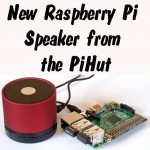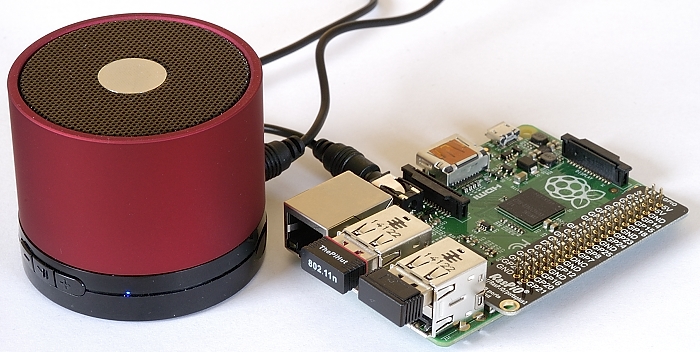
I got a new speaker in the post yesterday morning. It’s been redesigned specifically for the Raspberry Pi by ThePiHut. I charged it for a few hours (it has an internal lipo battery, which powers it for 7 hours of use) and then plugged it into the 3.5mm stereo outlet of an HDMIPi screen.
This takes the sound from the HDMI output of the Pi (so it’s digital and high quality, much better than the Pi’s analog output). I tested it with Bug Buck Bunny, which has superb graphics and sound. It also makes an excellent benchmark because it’s totally free and open source. That means I can use it in a video, which makes it possible for me to share the experience with you.
Amazingly Good Sound
I was totally amazed at the sound output quality. For its size and cost, the sound really is very good indeed. The video doesn’t really do justice to either the screen or the speaker, but it’s the nearest you can get on the internet. You need to see these in person for the full effect…
This speaker costs £12 from ThePiHut, available here.
A short while after making this video, the 3.5mm male to male lead started suffering an intermittent loose connection. Swapping for an alternative lead made the problem disappear immediately. So thankfully it wasn’t an issue with the speaker itself. I would have been upset because the speaker is lovely.
Manual Errata
The product manual needs some work though, as there is some incorrect information in it.
- You don’t need to charge the speaker before use, if you plug in the power lead.
- You can use it while it’s powered (even from the Pi USB port) but that may affect sound quality.
- There is no FM Radio or Bluetooth. Those features are for another model by the same manufacturer.

[…] Alex Eames got hold of a new speaker from The Pi Hut and has done a review video over on his site, RasPi.TV. Read and watch the video here. […]
This looks nice. One of my gripes about the Raspberry Pi is the output on the audio jack is really really small which is unfortunate because even on projects where you may only want something as simple as a few beeps you still need an amplifier. I’ve been told the output from the Pi is so weak it can’t even power headphones (although I’ve not tested that myself) so it should be considered more of a line out than a headphone jack. This product gives a lot of people an easy solution, although more compact projects will still have to use something else like a small amp or a USB sound card.
I don’t like to quibble, but as it has an internal battery and a microSD slot for playing MP3s, it seems like this was clearly designed as a portable MP3 player. How was it “designed specifically for the Raspberry Pi” ? Custom paint-job? ;)
Does it need to be “charged” first, or could it simply be permanently powered by plugging it’s miniUSB connector into one of the Pi’s USB ports?
Conveniently, ThePiHut currently has a sale on for a few days… :-)
LOL. Yes you do like to quibble. And it’s OK, we love you for it :)
I think Jamie would be the best person to direct that “How was it designed” question to. He told me it was designed for the Raspberry Pi. I don’t know the details of that, but he’s pretty open, so I’ll ask him.
It does need to be charged first, and I’m not sure if it can be used with the charge lead plugged in. (I don’t think so).(edited out incorrect comment)Well, if you don’t mind my quibbling… ;)
I’d say it might be a bit confusing that your intro text says “and then plugged it into the 3.5mm stereo outlet of an HDMIPi screen …. much better than the Pi’s analog output” and yet your picture immediately below it shows the speaker plugged into the analogue audio output of a B+ Pi!
Could you make some (obviously subjective) quick comments about the difference in quality between the HDMIPi audio-out, and the (improved) analogue audio-out on the B+ Pi?
Point taken. The blog was written after I shot the video and before I took the photo. I’ve amended the photo caption for clarity.
I haven’t tried it on the analog port of the Pi. (Just posed for the photo). But I think Mike is planning to try that angle in his upcoming review. :)
It could be that it has the gain adjusted specifically for the output level of the Raspberry Pi, but yeah it does seem to be a fairly generic product to me as well rather than something specific.
Jamie will be along shortly to answer the queries :)
Hey Andrew!
It took us a long time to get this speaker just right for the Pi (I have 20 samples from different factories in my cupboard from our testing phase)
We actually had to redesign the speaker’s guts for the Pi, to allow it to charge and play at the same time (we found most of the speakers in this format were not able to do this with the Pi as they saw it as a data device and tried to play its music via the USB). We did this to allow Pi users to not have to worry about the battery charge if they want to use their speaker all the time (IE in schools)
We also stripped out the unnesssaries (bluetooth and FM radio). Bluetooth was stripped to reduce the price and incrase battery life. FM was stripped because our sample class kept putting the speakers in FM mode – the static drove us nuts!
The speaker doesn’t need to be charged first (thanks to our mod)!
Yes indeed, bank holiday sale! Whoop!
Brilliant, thanks Jamie! :-D
I’ll probably be taking advantage of your sale tomorrow then… :)
Jamie – perhaps you could consider including some of the useful info you’ve just mentioned above on your speaker’s product-info page?
How am I supposed to use a monitor if this speaker takes up the HDMI port?
You must have misunderstood somewhere – this speaker connects to a regular 3.5mm audio jack.
In Alex’s video he connects the HDMI-out of the RPi to the HDMI-in of the HDMIPi display, and the HDMIPi has an extra audio-out which he’s connected the speaker to (since the digital-audio transmitted over HDMI – which the HDMIPi breaks out to a separate analogue audio-out jack – is higher-quality than the analogue audio-out available natively on the RPi itself).
But if you don’t have an HDMI display with built-in analogue audio-out (or if you’re using the composite video output), you can connect the speaker directly to the RPi’s audio-out.
(hope I haven’t confused you further!)
I recently bought one looking a lot like this (the Z-12 from DX) and its a handy portable device indeed. Very very cheap ($6,50 incl postage) and not too bad sound.
What I do not like about the Z-12 and what Pi Hut has corrected in their product, making it a much nicer to work with, is removing the default FM static noise at startup!
Ofcourse it is mono and a disgrace for the HDMIPi quality sound output!
LOL. I’m seeing about getting another so I can have one for each channel with an adaptor lead.